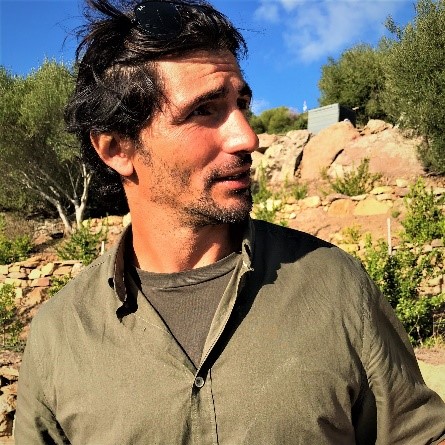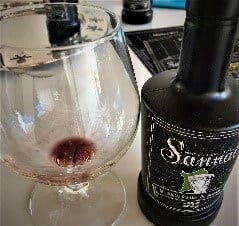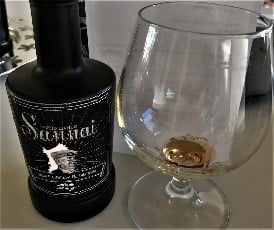
Sardinia: Headquarters for Sannai Mirto
There are many reasons to schedule a visit to Sardinia and they range from excellent wines and interesting cuisine to 4-5-star resorts, yachts and boating, swimming, sunning and the opportunity to rub shoulders with the rich (and maybe famous).
One reason that is unlikely to appear on the top 10 list (but should be there) is the opportunity to taste Mirto. While a few international locales import this locally produced liqueur, it is very difficult to find outside of Sardinia and Corsica.
Discover Mirto
Mirto is made from the myrtle plant (Myrtus communis) through the alcoholic maceration of the dark blue berries (similar to blueberries) or a compound of berries and leaves. The berries grow on small evergreen bushes that can grow up to five meters. The leaves contain valuable essential oils and used for medicinal purposes; the early Egyptians and Assyrians used the berries for their antiseptic and anti-inflammatory properties in treating ulcers.
In Greek mythology, Myrsine, a young girl, was transformed by Athena into the shrub because she dared to beat a male competitor in the games. Myrtle was worn by Athenian judges and woven into wreaths worn by Greek and Roman Olympians. As a token of peace and love, myrtle was part of bridal decorations.
The deep blue berries are elongated ovals and have a shiny exterior. When fresh, they are soft and aromatic. Beneath the blackish-blue skin the flesh is reddish-purple and filled with small kidney-shaped seeds
The nose finds sweet herbs, dried fruit and spice while the palate experiences cinnamon, cloves and maple, and even hints of almond. It is sweet, enveloping, warm and velvety taste experience. Although the PR suggests it as a digestive, Mirto over ice, as a spritzer or used as an important part of a cocktail makes it perfect for sipping throughout the day and evening.
Mirto Government Regulations
In 1994, the Sardinian Manufacturer’s Association of MIRTO liqueur was formed to protect the product and the consumer, regulating the production process so that the Mirto remained true to its history. The liqueur has the highest number of antioxidants of any food group in the Mediterranean diet, and is listed as a “commercial product;” however, Sannai, because of its handcrafted planting and sustainable production process, has developed a unique artisanal pathway for its product line that suggests it belongs in a exclusive food group.
Leading Sannai Mirto
While visiting Sardinia, I had the good fortune to visit the headquarters of Sannai Mirto, produced by Antonio Castelli, a retired professional soccer player (2015), and his wife Jenny Barazza, a member of the professional Italian volleyball team, Liujo-volley Modena. They met in 2008 and instantly bonded over their Achilles tendon injury.
Barazza was born in Connegliano (near Treviso and Venice, northern Italy), and started playing volleyball when she was very young. At 17 she joined an Italian league and won a championship, playing on the team until 2012. She has earned more than 130 caps for the Italian national team with whom she won the 2007 European Volleyball Championship, where she was named Best Blocker of the tournament and in 2012 attended the London Olympics. She continues to play and coaches a girls’ volleyball team.
Entrepreneurship @ Sannai
Together, Castelli and Barazza have developed Sannai Mirto which is locate in a small corner of northern Sardinia on the eastern slope of Mount Plebi, an area that could not be more scenic (and remote). From the hilltop there are views of the Mediterranean, Porto Rotondo and the beaches of the Emerald Coast. Myrtus Communis (aka myrtle/mirto berries) thrives here as it is blessed by the sun and refreshed by the sea breezes. When visiting the Sannai headquarters it is wonderful to notice the acres of mirto berries, the small and efficient production workshop, insulated infusion and storage areas and the comfortable and personal tasting zone.
Sannai is a combination of the name of the founder’s maternal grandfather, Giorgio Sanna, and the road leading to the estate, Sannai. The logo features the image of the late Giorgio Sanna and behind the photo is a silhouette of Sardinia. The philosophy of Sannai is: Maneras Anticas, fainas Novas trans: ancient methods in new products or the old within the new. The Sannai method is based on the use of family recipes and a reminder of family sacrifices that enables the luxuries of today.
Sannai Mirto liqueurs are not treated with pesticides and the terroir is cultivated manually with hoes, pruning shears, water (when necessary) from an irrigation system, combined with the personal sweat and efforts of Castelli and Barazza.
The berries are handpicked by Antonio Castelli who uses the maximum number of berries for the infusions. The harvest begins immediately after the first winter frost, in the early morning when they have the best organolepic characteristics. The infusions use berries that have been picked, washed and dried in the open air (never frozen). The Sannai Mirto can deteriorate in sunlight and air so it is stored in a climate-controlled cellar without light. This is also the reason that the small bottles are painted black.
The Mirto Collection
1. Mirto di Bacche. Made from an infusion of myrtle berries in 100 percent Italian wheat alcohol. Ruby red in color, with an aroma of rosemary, eucalyptus and juniper. Enjoy as a digestive or used in cocktails. Pair with meat and venison.
2. Mirto di Bacche e Foglie. Infusion made from selected berries and scented myrtle leaves in 100 percent Italian wheat alcohol. Look for a strong berry flavor with hints of rosemary, resin and spices. Enjoy as a digestive or aperitif.
3. Mirto e Miele. Bright red to the eye, the palate finds balsamic and vegetables. Made by infusing myrtle berries in 100 percent Italian wheat alcohol, sweetened with asphodel honey. Enjoy as a digestive or as a topping for ice cream and/or strawberries.
For additional information, click here.
Sannai Mirto







© Dr. Elinor Garely. This copyright article, including photos, may not be reproduced without written permission from the author.
